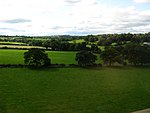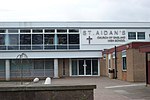Crimple Valley Viaduct

Crimple Valley Viaduct, also known as Crimple Viaduct and Crimple Beck Viaduct is a railway viaduct which crosses the Crimple Valley between Pannal railway station and Hornbeam Park railway station in North Yorkshire. It is a Grade II* listed structure.It is 1,872 feet (571 m) long and has 31 arches, each of 52-foot (16 m) span, which reach a maximum height of 110 feet (34 m) above the Crimple Valley. The sharp bend in the track on the south side of the viaduct causes trains to reduce speed significantly, especially on the northbound journey. Older Pacer rolling stock units are locally known to loudly squeal whilst passing around the tight bend due to increased pressure on the bogies and wheels. It was completed in 1848 to designs by George Hudson for the York and North Midland Railway company and built of rusticated grit stone ashlar. The contractor was James Bray.
Excerpt from the Wikipedia article Crimple Valley Viaduct (License: CC BY-SA 3.0, Authors, Images).Crimple Valley Viaduct
Fulwith Mill Lane,
Geographical coordinates (GPS) Address External links Nearby Places Show on map
Geographical coordinates (GPS)
| Latitude | Longitude |
|---|---|
| N 53.972997222222 ° | E -1.5166861111111 ° |
Address
Crimple Valley Viaduct
Fulwith Mill Lane
HG2 8HJ
England, United Kingdom
Open on Google Maps







